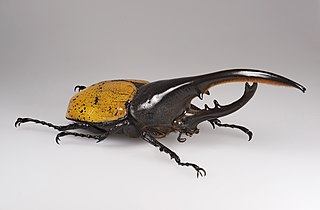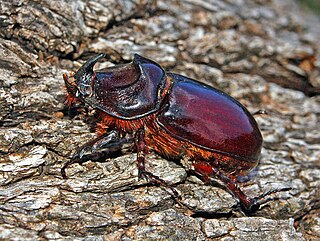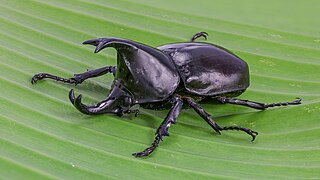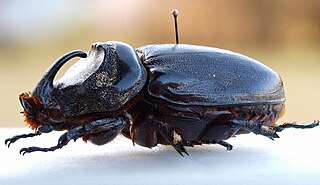
The Hercules beetle is a species of rhinoceros beetle native to the rainforests of southern Mexico, Central America, South America, and the Lesser Antilles. It is the longest extant species of beetle in the world, and is also one of the largest flying insects in the world.

Dynastinae or rhinoceros beetles are a subfamily of the scarab beetle family (Scarabaeidae). Other common names – some for particular groups of rhinoceros beetles – include Hercules beetles, unicorn beetles or horn beetles. Over 1500 species and 225 genera of rhinoceros beetles are known.

The European rhinoceros beetle is a large flying beetle belonging to the subfamily Dynastinae.

Xylotrupes ulysses, common names "Elephant beetle", "Coconut palm beetle", "common rhinoceros beetle" or simply "rhinoceros beetle" is a species of rhinoceros beetle native to New Guinea. Male horns in several groups of this genus represent a special secondary sex characteristic. There is a bimodal horn-size distribution and there is a discrete male mating behavior correlated with each phenotype.

Xylotrupes is a genus of rhinoceros beetles, with more than 25 species and subspecies distributed worldwide, but especially in Asia.

Oryctes is the most economically important genus of rhinoceros beetles in the subfamily Dynastinae, since it includes a notorious insect pest of palms.

Xylotrupes socrates, commonly known as the Siamese rhinoceros beetle or fighting beetle, is a species of large scarab beetle belonging to the subfamily Dynastinae. It is particularly known for its role in insect fighting in Thailand.
Xylotrupes siamensis is a species of rhinoceros beetle found across Asia.
Catharsius capucinus, is a species of dung beetle found in India, Sri Lanka, Bangladesh and Nepal.
Phyllognathus dionysius, is a species of dung beetle found in India, Sri Lanka, Pakistan and Nepal.

Digitonthophagus bonasus, is a species of dung beetle found in India, Sri Lanka, Pakistan, Nepal, Myanmar, Thailand, Afghanistan, Vietnam and Cambodia.
Dipelicus bidens, is a species of dung beetle native to India and Sri Lanka.

Gymnopleurus gemmatus, is a species of dung beetle found in India, and Sri Lanka.

Onthophagus dama, is a species of dung beetle found in Nepal, Bhutan, India, and Sri Lanka.
Onthophagus favrei, is a species of dung beetle found in India, and Sri Lanka.
Onthophagus hastifer, is a species of dung beetle found in India, Sri Lanka, Vietnam, Taiwan, Thailand, and Myanmar.

Onthophagus rectecornutus, is a species of dung beetle found in India, Sri Lanka, Nepal, China, Sunda Islands and Thailand.

Oryctes gnu, commonly known as Malaysian rhinoceros beetle, is a species of dung beetle native to South Asian and South East Asian countries including: India, Pakistan, Sri Lanka, Philippines, Thailand, Philippines, and Vietnam. It is also introduced to many parts of the world.
Xylotrupes meridionalis, commonly known as forked horns rhinoceros beetle, is a species of rhinoceros beetle found in India and Sri Lanka.
Xylotrupes taprobanes, is a species of rhinoceros beetle found in India and Sri Lanka.













